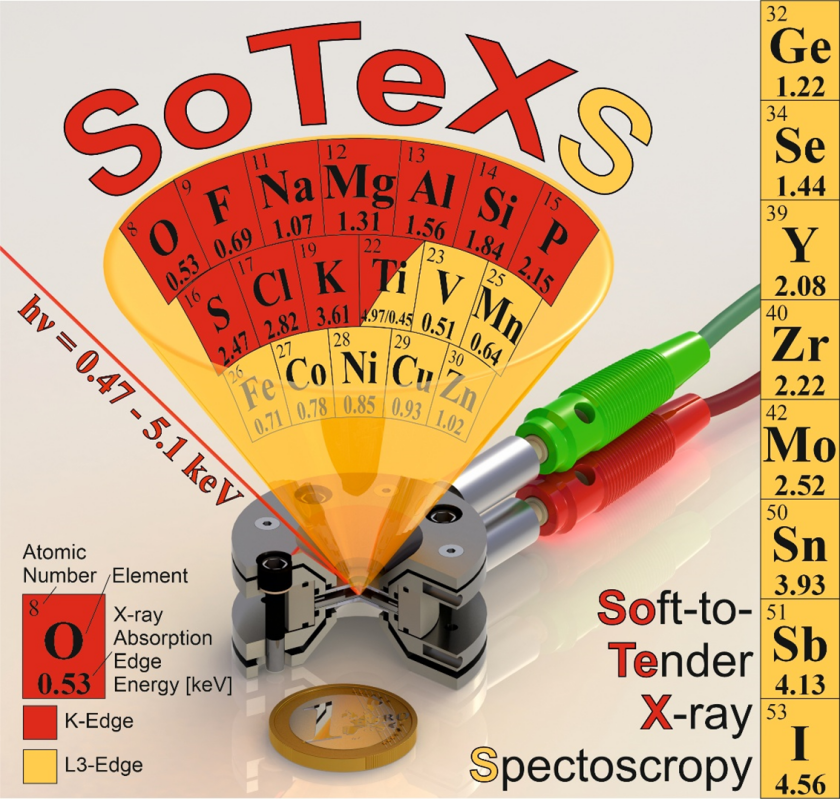Institute Electrochemical Energy Storage
SoTeXS

Conceptualization of an endstation for operando spectroscopy of batteries at new SoTeXS beamline
Introduction
The SoTeXS (Soft-to-Tender X-Ray Spectroscopy) project at Helmholtz-Zentrum Berlin (HZB) develops a new beamline that will revolutionize battery research through detailed analyses in the soft and tender X-ray range (0.5-5 keV). This project complements the existing portfolio of 12 beamlines at HZB and is an integral part of the planned battery hub in collaboration with the Physikalisch-Technische Bundesanstalt (PTB), the Technical University Berlin (TUB) and the Bundesanstalt für Materialforschung und -prüfung (BAM).
Scientific Objectives
- Electrochemical Processes: Investigate element concentrations and oxidation states in battery materials during operation.
- Degradation Mechanisms: Analyze degradation processes to develop longer-lasting batteries.
- Material Development: Support the development of new, sustainable, and efficient energy storage materials.
- Element Analysis: Utilize the soft and tender X-ray range to study relevant elements (O, F, Na, Mg, Al, Si, P, Cl, S, K, Ti, Mn, Fe, Co, Ni, Cu, Zn, Mo).
- Quantitative Analysis: Ensure accurate measurements through collaboration with PTB.
- Industrial Calibration: Provide calibrated samples for industrial X-ray equipment.
- Digital Twins: Enable simulations to predict battery performance.
Unique Features and Advantages
- Broad Energy Range: Unique continuous energy range of 0.5-5 keV.
- Fast Measurements: High-flux CPMU and fast ML-PGM for efficient data acquisition.
- High Precision: Calibrated instrumentation and collaboration with PTB for accurate measurements.
- Industrial Relevance: Metrological focus and provision of calibrated samples for industrial applications.
- Modular Design: Adaptability to future synchrotron facilities.
- Advanced Data Analysis: Use of AI and machine learning for data analysis.
- Innovative Sample Environment: Automated sample changer for high-throughput and long-term studies.
- Reduction of Radiation Damage: lateral scans and large detector solid angles to reduce radiation damage.
- Multimodal Correlation: Enabling the correlation of various measured quantities.
Technical Details
- Cryogenic Permanent Magnet Undulator (CPMU): High photon flux.
- Fast-Scanning Multi-Layer Plane Grating Monochromator (ML-PGM): Rapid energy scans.
- Calibrated Instrumentation: Accurate measurements with large detection angle.
Significance and Benchmarking
- SoTeXS will attract a broad user base from battery, solar cell, and catalysis research.
- The project builds on HZB's long-standing experience in X-ray spectroscopy.
- SoTeXS will meet state-of-the-art requirements and enable multimodal correlations.
- Compared to other synchrotrons, SoTeXS offers unique advantages in terms of speed, precision, and industrial relevance.
Conclusion
SoTeXS is a strategically important project that will significantly advance battery research at HZB and beyond. Through its unique features and collaboration with key partners, SoTeXS will be an indispensable tool for the development of sustainable and efficient energy storage solutions.
